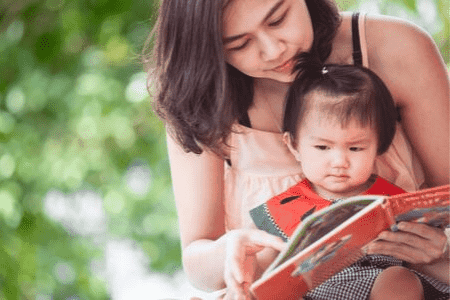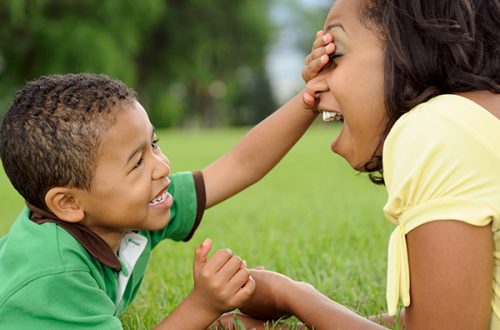Building Baby's Library
By Jan Pierce
Books Matter
Educators tell us that every child needs to hear five hundred books read aloud to them before entering Kindergarten. Hearing all those stories prepares boys and girls for learning to read. They’ll pick up important “book knowledge” such as concepts of words and sentences, left to right orientation, top and bottom, the beginning, middle and end of a book and much more.

They’ll learn to enjoy book language which is different from everyday speaking. They’ll move and bounce to the rhythms of words, they’ll learn to love characters who do silly things and they’ll giggle at funny pictures. They’ll learn there are books about virtually everything in the whole wide world.
They’ll learn something else from hearing their parents and other significant people in their lives read to them—they’ll learn to love reading. Since one of the primary indicators of success in school is learning to read, parents are wise to pour themselves into building baby’s love of and immersion in books. Many medical professionals believe children can even begin to enjoy language and music before they’re born. It’s never too early to read aloud to baby.
Given the importance of baby’s exposure to good books, let’s explore the kinds of books to put into your family’s library. The benefits of board books for babies are many. They’re usually small enough for little hands to hold easily. The pictures are simple and clear and the print is large. The heavy, durable quality of the paper means the books will last through hundreds of readings and can even survive an inadvertent dip in water or a few nibbles from baby’s teeth. In addition you’ll be assured that a board book is appropriate for baby—not too difficult in language and topic.
Know the Classics
When it comes to books for baby there are some classics you just don’t want to miss. Anything by Eric Carle will delight babies. His Very Hungry Caterpillar or The Very Busy Spider are just right for exposure to beautiful pictures and a simple story. Margaret Wise Brown’s Goodnight Moon, Mem Fox’s Hello Baby and Bill Martin books so full of rhythm and rhyme are also classics. Bill Martin’s Chicka Chicka Boom Boom and his collaboration with Eric Carle on Brown Bear, Brown Bear are two selections that should be on every baby library shelf. Other popular titles include Pat the Bunny by Dorothy Kunhardt and The Snowy Day by Ezra Jack Keats. Other authors with wonderful books for baby are Tana Hoban, Sandra Boynton and Philip Eastman.
There are other books written for the purpose of exposing baby to specific topics or skills. The Baby Gym Books by Sanja Rescek introduce the five senses in titles such as Wiggle and Move, Touch and Tickle, Bounce and Jiggle and Calm and Soothe. My Little Quiet Books by Pockets of Learning teach baby beginning concepts of color, counting, opposites and recognition of animals. Spots and Dots by Chez Picthall are wordless books meant for newborns to babies six months of age. They introduce visual stimulation through high contrast images in black and white and in bold colors. Every book store and library have special sections of books just for baby. For those with tight budgets you might consider regular use of your local library and build a “rotating library” at home. In addition your local library will have read aloud times to introduce you to new titles and teach baby to sit and listen to another adult read.
Skill Building
In addition to the sheer pleasure of hearing books read aloud, babies also love the cuddly closeness of sitting with their readers. They’ll learn to point to certain objects and characters. In fact there are lots of books for babies and toddlers meant specifically for building recognition of shapes, colors, objects, parts of the body, familiar animals and the like. The skill of hearing the name for an object and then finding it on the page is not only a book skill, it’s also related to beginning math skills such as sorting objects into categories.
Many books for babies and toddlers will build skills. Color recognition, shape recognition, and learning to count are early skills necessary for success in school activities later on. The subtle skills of noticing the emotions of characters, the action of a story and lessons learned will also set the stage for later reading comprehension skills.
Quality books for your baby are the building blocks of future literacy. Your efforts to make books available and your time spent reading aloud to your baby will be rewarded many times over when it comes time for your child to become an independent reader.
You may enjoy going to the website for the American Library Association (www.ala.org). Here you’ll find their book list for babies entitled Born to Read. It includes books in categories such as:
- Books with sharp color contrast
- Books with bright colors
- Books with human faces (studies show babies look longer at these than any other image)
- Books of common objects or first words
- Books on concepts
- Books on daily routines
- Books babies can manipulate
- Books showing diversity
- Books with the best stories for babies
Best Books to Choose for Babies
- Choose sturdy board books or washable cloth or vinyl books
- Choose bright colors and simple pictures on solid backgrounds
- Babies respond to rhythm in language and simple rhymes
- Babies enjoy seeing pictures of familiar objects such as animals, food or clothing
- Babies love stories about the things they do such as eating, taking a bath or going to sleep
- Babies like repetition. They like books with repeated words or phrases
- Babies like to touch a variety of textures and help to turn pages in a book
- Babies love to read homemade books with pictures of their family members







